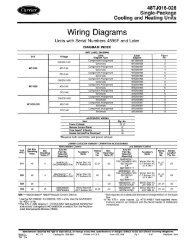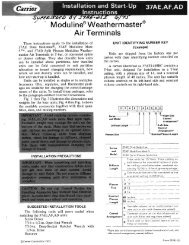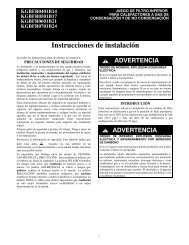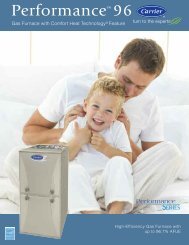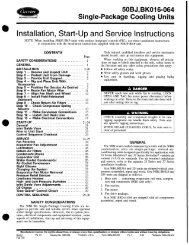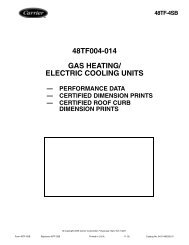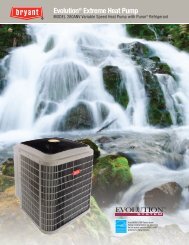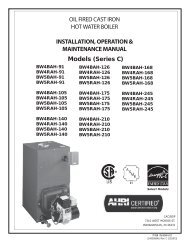Start-Up, Operation, and Maintenance Instructions
Start-Up, Operation, and Maintenance Instructions
Start-Up, Operation, and Maintenance Instructions
Create successful ePaper yourself
Turn your PDF publications into a flip-book with our unique Google optimized e-Paper software.
MOTOR<br />
COOLING LINE<br />
TXV BULB PRESSURE<br />
TRANSDUCER<br />
STARTING EQUIPMENT<br />
ISOLATION<br />
VALVE<br />
OIL<br />
COOLER<br />
REAR MOTOR<br />
BEARING<br />
OIL PUMP<br />
MOTOR<br />
The 19XR requires a motor starter to operate the centrifugal<br />
hermetic compressor motor, the oil pump, <strong>and</strong> various auxiliary<br />
equipment. The starter is the main field wiring interface for<br />
the contractor.<br />
See Carrier Specification Z-415 for specific starter requirements,<br />
Z-416 for free-st<strong>and</strong>ing VFD requirements <strong>and</strong> Z-417<br />
for unit-mounted VFD requirements. All starters must meet<br />
these specifications in order to properly start <strong>and</strong> satisfy mechanical<br />
safety requirements. <strong>Start</strong>ers may be supplied as separate,<br />
free-st<strong>and</strong>ing units or may be mounted directly on the<br />
chiller (unit mounted) for low voltage units only.<br />
Three separate circuit breakers are inside the starter. Circuit<br />
breaker CB1 is the compressor motor circuit breaker. The disconnect<br />
switch on the starter front cover is connected to this<br />
breaker. Circuit breaker CB1 supplies power to the compressor<br />
motor.<br />
The main circuit breaker (CB1) on the front of the starter<br />
disconnects the main motor current only. Power is still<br />
energized for the other circuits. Two more circuit breakers<br />
inside the starter must be turned off to disconnect power to<br />
the oil pump, PIC II controls, <strong>and</strong> oil heater.<br />
Circuit breaker CB2 supplies power to the control panel, oil<br />
heater, <strong>and</strong> portions of the starter controls.<br />
Circuit breaker CB3 supplies power to the oil pump. Both<br />
CB2 <strong>and</strong> CB3 are wired in parallel with CB1 so that power is<br />
supplied to them if the CB1 disconnect is open.<br />
All starters must include a Carrier control module called the<br />
Integrated <strong>Start</strong>er Module (ISM), excluding the Benshaw<br />
OIL<br />
PUMP<br />
OIL<br />
HEATER<br />
EDUCTOR<br />
SIGHT GLASS<br />
9<br />
FWD MOTOR<br />
BEARING<br />
Fig. 4 — Lubrication System<br />
LABYRINTH<br />
GAS LINE<br />
FILTER<br />
OIL SUPPLY TO<br />
FORWARD HIGH<br />
SPEED BEARING<br />
ISOLATION<br />
VALVE<br />
FILTER<br />
SIGHT<br />
GLASS<br />
ISOLATION<br />
VALVE<br />
OIL SKIMMER LINE<br />
solid-state starters. This module controls <strong>and</strong> monitors all aspects<br />
of the starter. See the Controls section on page 10 for additional<br />
ISM information. All starter replacement parts are supplied<br />
by the starter manufacturer excluding the ISM (contact<br />
Carrier’s Replacement Component Division [RCD]).<br />
Unit-Mounted Solid-State <strong>Start</strong>er (Optional) —<br />
The 19XR chiller may be equipped with a solid-state, reducedvoltage<br />
starter (Fig. 5 <strong>and</strong> 6). This starter’s primary function is<br />
to provide on-off control of the compressor motor. This type of<br />
starter reduces the peak starting torque, reduces the motor inrush<br />
current, <strong>and</strong> decreases mechanical shock. This capability<br />
is summed up by the phrase “soft starting.” The solid-state<br />
starter is available as a 19XR option (factory supplied <strong>and</strong> installed).<br />
The solid-state starters manufacturer name is located<br />
inside the starter access door.<br />
A solid-state, reduced-voltage starter operates by reducing<br />
the starting voltage. The starting torque of a motor at full voltage<br />
is typically 125% to 175% of the running torque. When the<br />
voltage <strong>and</strong> the current are reduced at start-up, the starting<br />
torque is reduced as well. The object is to reduce the starting<br />
voltage to just the voltage necessary to develop the torque required<br />
to get the motor moving. The voltage is reduced by silicon<br />
controlled rectifiers (SCRs). The voltage <strong>and</strong> current are<br />
then ramped up in a desired period of time. Once full voltage is<br />
reached, a bypass contactor is energized to bypass the SCRs.<br />
When voltage is supplied to the solid-state circuitry (CB1<br />
is closed), the heat sinks in the starter as well as the wires<br />
leading to the motor <strong>and</strong> the motor terminal are at line voltage.<br />
Do not touch the heat sinks, power wiring, or motor<br />
terminals while voltage is present or serious injury will<br />
result.







